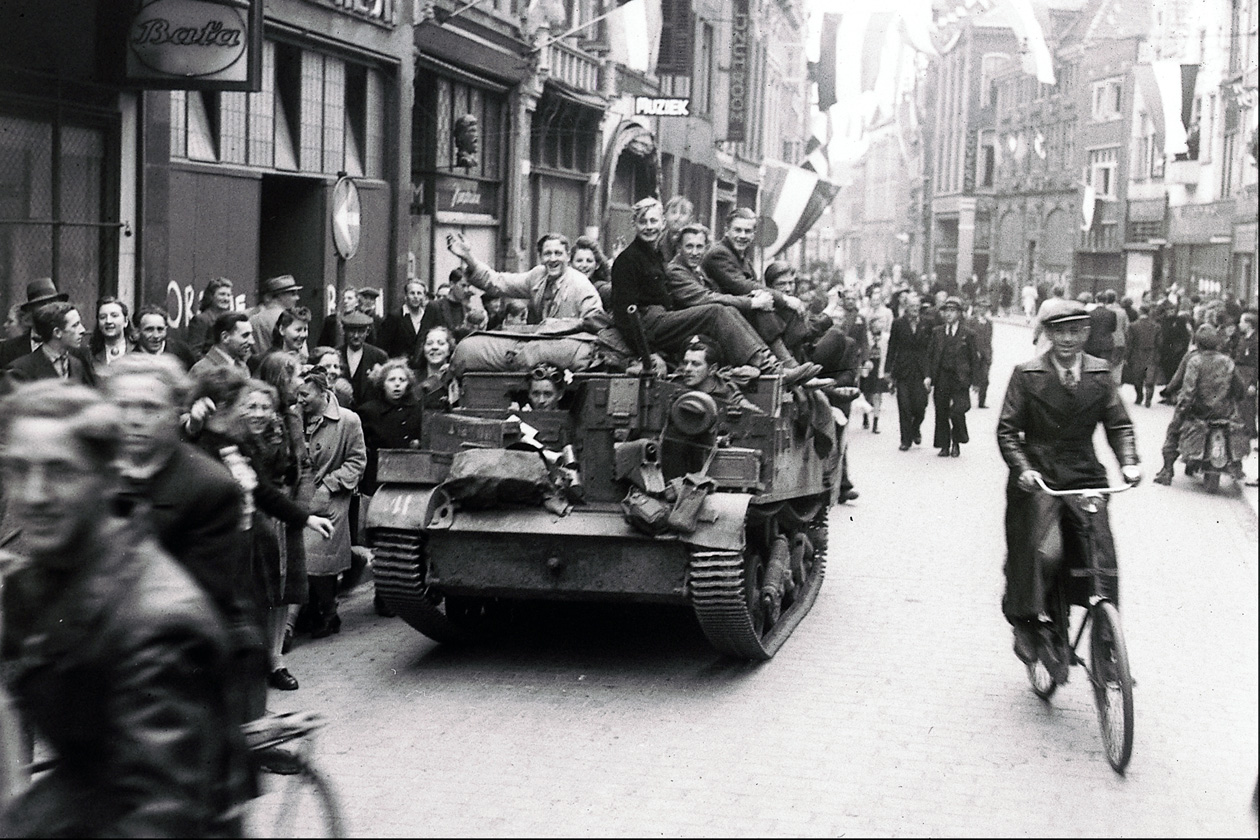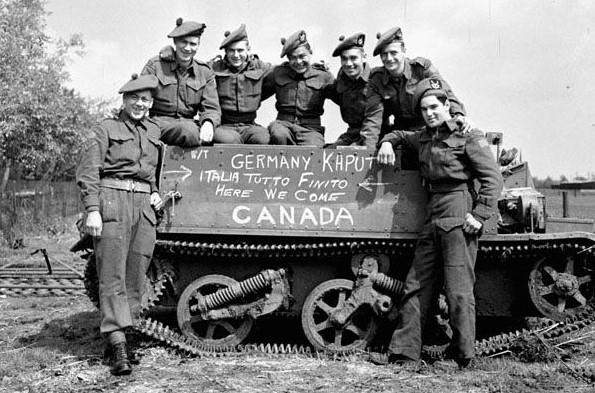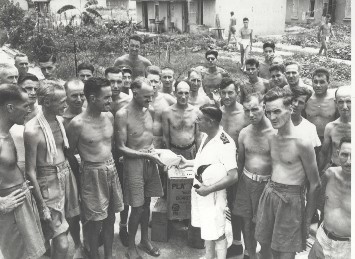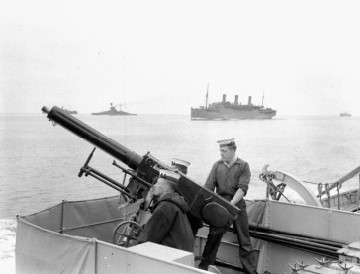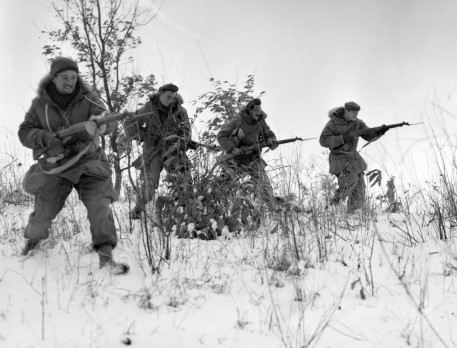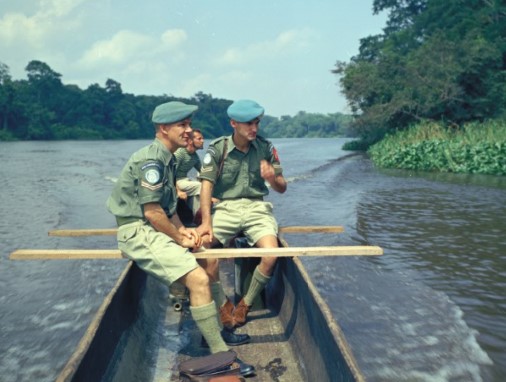Canada Remembers Times
Veterans’ Week Special Edition
5-11 November 2020 - Page 1
Remembering the Netherlands
Dutch residents welcome Canadian soldiers after the liberation of the town of Zwolle on 14 April 1945.
Image: Library and Archives Canada PA-136176
The Liberation of the Netherlands during the Second World War was one of the best-known chapters in our country’s long military history. In late 1944 and early 1945, the Canadians battled to push the Germans from the country they had occupied since the spring of 1940. With its challenging terrain, the Netherlands was a tough place to fight.
After opening battles in the fall of 1944, bad weather brought the offensive to a halt. That winter was a terrible time for the Dutch—food and fuel supply reserves were gone; people ate tulip bulbs and scavenged through garbage to survive. Thousands starved or froze to death.
Early in the new year, the push began anew to liberate the entire country and finally end the war in Europe. The Canadian troops were cheered as one town after another was freed. Veteran Robert Greene recalled of the liberation of the town of Emmelo:
“And in the town square, we moved our tanks in and within minutes, there were probably a couple of thousand people… And I got up in the turret and started the people singing the Dutch national anthem. And there wasn’t a dry eye to the place, 2,000 people. They hadn’t been able to sing for five years.”
The Liberation of the Netherlands was a proud achievement for our country but one that came at a great cost with more than 7,600 Canadians losing their lives. This spring marked the 75th anniversary of this important milestone. The Dutch people have never forgotten the help we offered in their time of need and a strong international friendship between our two countries continues today.
V-E Day at last!
Happy Seaforth Highlanders of Canada soldiers in the Netherlands in May 1945.
Photo: Library and Archives Canada PA-137741
The Second World War was the bloodiest conflict in human history. It began in September 1939 and the fighting in Europe would rage until May 1945. Canada joined many other countries to form the Allied powers which fought to restore peace and freedom to the continent.
Our soldiers, sailors and aviators played an important role in helping achieve victory. As the war neared its end, Canadian troops took part in the bitter campaign in Northwest Europe in 1944 and 1945. They saw heavy action in France, Belgium, the Netherlands and Germany before the enemy was finally forced to surrender in early May.
The western Allies declared 8 May 1945 to be Victory in Europe (V-E) Day. After years of hardship, suffering and sacrifice, millions around the world celebrated the end of the fighting. Peace in Europe had come at last.
V-J Day and freedom
Naval officer with liberated Canadian prisoners of war in Hong Kong after the Japanese surrender.
Photo: Library and Archives Canada PA-193015
Some 10,000 Canadians served in Asia during the Second World War. This included almost 2,000 soldiers from Manitoba’s Winnipeg Grenadiers and Quebec’s Royal Rifles of Canada who were sent across the Pacific Ocean in the fall of 1941 to help defend the British colony of Hong Kong.
The Japanese invaded Hong Kong on 8 December 1941. Badly outnumbered, the defenders fought bravely before being forced to surrender on Christmas Day. Approximately 290 Canadians were killed and almost 500 wounded. The survivors’ ordeal was just beginning. Over the next four years, 267 more would die as a result of malnutrition, beatings by prison guards and forced labour. George MacDonell of Ontario was a young company sergeant major who said of the desperate fighting in Hong Kong:
“We immediately were engaged and the Canadians fought extremely well in a hopeless situation. There wasn’t anybody there that did not know that we were in a terrible spot…”
Thousands of Royal Canadian Air Force members also served in Asia during the conflict. Most of them would take part in the Burma Campaign, working as radar operators and members of bomber, transport, reconnaissance and fighter squadrons.
Japan surrendered on 15 August 1945, after atomic bombs were dropped on Hiroshima and Nagasaki. Victory over Japan (V-J) Day marked the end of almost six years of fighting in the Second World War. The Canadian prisoners of war were finally liberated and could return home.
Winning the war on the high seas
HMCS Assiniboine sailors manning an anti-aircraft gun while escorting a convoy in July 1940.
Photo: Library and Archives Canada PA-104057
The Battle of the Atlantic was the longest campaign of the Second World War. This bitter struggle at sea lasted from the first day of the conflict in September 1939 to the end of the fighting in Europe in May 1945. It was a showdown between the Allies, who needed to transport supplies and troops from North America to Europe, and the Germans, who wanted to cut that vital lifeline.
It was a hard-fought struggle in which the German U-boats (submarines) came dangerously close to victory as they torpedoed hundreds of Allied transport ships in the opening years of the war.
With courage and the adoption of new technology and tactics, however, the tide turned and the Allies would eventually triumph in the war at sea.
Members of the Royal Canadian Navy, Canadian Merchant Navy and Royal Canadian Air Force played leading roles in this battle. Indeed, more than 25,000 Allied merchant ships safely made it to their destination under Canadian escort, delivering some 165 million tons of supplies to Europe. The cost of helping the convoys get through was high—some 2,000 of our sailors died during the conflict, 750 Canadian airmen lost their lives over the Atlantic and more than 1,600 of our merchant seamen were killed. But without victory in the Battle of the Atlantic, the Allies could not have triumphed in the Second World War.
Going to war in Korea
Princess Patricia’s Canadian Light Infantry soldiers in Korea in March 1951.
Photo: Library and Archives Canada PA-171327
The Korean War erupted 70 years ago when North Korean troops poured across the border into South Korea on 25 June 1950. Traditionally known as the “Land of the Morning Calm,” Korea would be ravaged by more than three years of bitter fighting. More than 26,000 brave Canadians travelled halfway around the world to fight with the United Nations forces and Charlie Rees of Newfoundland was there:
“When you go into war, you know you’re going to see fellas wounded, killed… So you have to take it all in stride, but you feel hurt. Everybody does when he sees a buddy killed or a buddy wounded… I think it myself today. How lucky I was, you know, compared to some of the other fellas.”
When an armistice was finally signed on 27 July 1953, the border was back close to where it had been before the conflict. Our country had helped restore peace and freedom to the people of South Korea—a peace paid for in part by the 516 Canadian servicemen who died during the war. No formal peace treaty was ever signed, however, and tensions between North and South Korea remain high today.
Peacekeeping in the Congo
Two Canadian peacekeepers travelling on the Congo River in 1961.
Photo: Department of National Defence
Canadian service members have taken part in many peace support efforts in Africa over the years. One of the first was in the Congo in 1960. Hundreds of Canadians served in the troubled country as part of a large-scale United Nations (UN) peacekeeping mission that ran for four years.
It was an eye-opening experience for our military personnel tasked with peacekeeping in a place with so little peace to keep. Weapons and violence were widespread in a society that had been torn apart in the aftermath of its colonial period as a Belgian possession. Despite some successes, in the end the UN troops were unable to stop the greater forces of upheaval rocking the Congo and they departed in 1964. Sadly, two Canadian soldiers lost their lives there.
The political situation in the Congo has remained volatile and a small Canadian Armed Forces contingent has again been serving in the country in recent years.
- Date modified:
